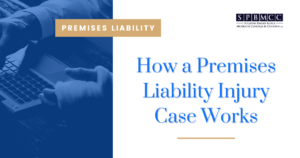How a Premises Liability Injury Case Works
May 26, 2021 in Premise Liability
Premises liability cases fall under the category of personal injury cases. They can arise when a property owner is potentially legally responsible for injuries sustained in an accident on their property, typically if the accident is due to the unsafe conditions of their property.
Slip and fall accidents, construction site accidents, fires, or even criminal attacks can all be viable grounds for a premises liability claim. Here, the qualified personal injury attorneys at Sullivan Papain Block McManus Coffinas & Cannavo P.C. outline the elements of a premises liability injury case and how seeking the assistance of a personal injury attorney can be beneficial if you are a victim.

What Must Be Proven in a Premises Liability Case?
Primarily, you must prove that the defendant either owned, occupied, or leased the premises. This will demonstrate that the defendant had a lawful duty to ensure that the premises were safe and in reasonable condition.
As the plaintiff, you must then prove that the defendant was negligent regarding the use of the premises. In other words, you must prove that the defendant failed to carry out the standard of care, and subpar conditions caused you unintentional harm.
What is an Example Scenario That Could Be Grounds For a Premises Liability Lawsuit?
Let us analyze a slip-and-fall scenario: if a grocery store were to undergo a scheduled cleaning where floors would be mopped, the grocery store manager and staff members would have the responsibility of placing a wet floor sign near the hazard. If they failed to properly warn shoppers of the hazard, and a patron were to slip and injure themselves, the storefront would be liable for the incident.
In most cases, the negligence of the defendant is based on the status of the person on the property or land. The person entering the land is either an invitee, a licensee, or a trespasser. Depending on this status, the defendant owes a different duty of care. For example, to an invitee, the defendant owes a duty of reasonable care regarding the maintenance of the premises, while to a trespasser, the defendant owes no duty of care other than refraining from imposing deliberate harm. There are some cases, however, in which the negligence of the defendant is based on ordinary negligence, in which the defendant has a duty to warn of potential dangers that you are not aware of and could not possibly discover on your own.
There are other instances where an individual who became injured on private property may not have a viable case against the property owner. For example, if the plaintiff is acting out of reckless disregard while on the defendant’s premises, and subsequently hurts themselves due to their behavior or disregarding their surroundings, this may not be grounds for a premises liability lawsuit.
How Do You Prove Your Injury in a Premises Liability Case?
After proving the defendant’s negligence, you must show proof of your injury and how that injury will affect your day-to-day life. Proof of injury can be demonstrated through your testimony, medical bills, or even the testimony of the treating medical professional. Lastly, you must prove that the defendant’s negligence played a substantial role in the cause of your injuries. The defendant’s negligence does not need to be the sole cause of the harm you suffered, but you must prove that your injuries are likely resulting from the defendant’s actions or lack thereof.
The New York Personal Injury Lawyers at SPBMCC are Actively Taking Cases
If you were injured on private property due to the alleged negligence or careless behavior of the property owner, you may have a viable premises liability case. The team of qualified and experienced personal injury attorneys at Sullivan Papain Block McManus Coffinas & Cannavo P.C. are here to assist you throughout the entire legal process. To learn more about our services or schedule a free consultation regarding your personal injury case, contact us today by calling 212-732-9000 or by filling out a form here.